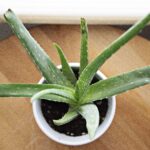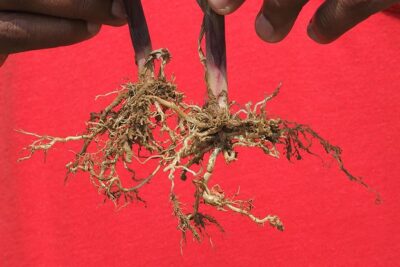
Will Succulent Leaves Regrow If They Fall Off: The Complete Guide

Succulents have become increasingly popular as houseplants and garden additions due to their unique and striking appearance. One common concern among succulent enthusiasts is whether the leaves of these plants can regrow if they fall off. Understanding the regrowth potential of succulent leaves is essential for proper care and maintenance.
We will explore the fascinating world of succulent leaf regrowth. We will discuss the different types of succulents and their ability to regrow leaves, the factors that influence leaf regrowth, and the steps you can take to encourage the regrowth process. Whether you are a seasoned succulent lover or a beginner seeking to learn more about these resilient plants, this complete guide will provide you with all the information you need to know about succulent leaf regrowth.
- Yes, succulent leaves can regrow if they fall off
- To regrow, the fallen leaf needs to be healthy and undamaged
- Place the fallen leaf on top of well-draining soil
- Water the leaf sparingly to prevent rot
- Keep the leaf in a bright but indirect sunlight
- It may take several weeks for the leaf to develop roots
- Once roots are established, a new plantlet will start to grow
- Eventually, the new plantlet will form its own roots and can be transplanted
- Frequently Asked Questions
Yes, succulent leaves can regrow if they fall off
One of the fascinating aspects of succulent plants is their unique ability to regrow from fallen leaves. Many succulent enthusiasts may wonder, "Will succulent leaves regrow if they fall off?" The answer is a resounding yes!
Succulents, with their thick and fleshy leaves, have mastered the art of propagation through leaf propagation. This means that if a succulent leaf accidentally falls off or is intentionally plucked, it has the potential to regenerate into a whole new plant.
How do succulent leaves regrow?
When a succulent leaf detaches from its parent plant, it contains all the necessary genetic material and nutrients needed to develop into a new plant. The process of growing a new plant from a fallen leaf is known as vegetative propagation.
 Succulents: Growing from Seeds or Cuttings?
Succulents: Growing from Seeds or Cuttings?The steps to regrow succulent leaves:
- Allow the leaf to callous: After a succulent leaf falls off, it is crucial to give it time to callous over before planting it. This callousing process helps prevent rot and infection.
- Prepare a well-draining soil mixture: Succulents thrive in well-draining soil. Combine equal parts of succulent soil and perlite or pumice to create a suitable growing medium.
- Place the leaf on top of the soil: Gently lay the calloused end of the leaf on the soil surface. Avoid burying the leaf as this may hinder its ability to root properly.
- Provide indirect sunlight: Succulent leaves need bright but indirect sunlight to initiate root growth. Placing them near a window or under a grow light can facilitate the process.
- Maintain optimal moisture levels: While it is essential to keep the soil slightly moist, overwatering can lead to root rot. Water the leaf propagation sparingly, allowing the soil to dry out between waterings.
- Be patient: It can take several weeks or even months for a succulent leaf to develop roots and start sprouting new growth. Patience is key during this process.
Which succulent leaves can regrow?
While many succulent species have the ability to regrow from fallen leaves, it's important to note that not all leaves will successfully propagate. Some succulents, such as Echeveria, Crassula, and Sedum, are known for their high success rates in leaf propagation.
Final thoughts
So, to answer the question, "Will succulent leaves regrow if they fall off?" Yes, they certainly can. By following the proper steps and providing the necessary conditions, you can enjoy the rewarding experience of watching a fallen succulent leaf transform into a brand new plant. Happy propagating!
To regrow, the fallen leaf needs to be healthy and undamaged
To regrow, the fallen leaf needs to be healthy and undamaged
One common question among succulent enthusiasts is whether or not succulent leaves will regrow if they fall off. The answer to this question depends on a few factors, but the most important one is the health and condition of the fallen leaf.
 Gentle Techniques for Removing Succulent Offshoots
Gentle Techniques for Removing Succulent OffshootsHealthy leaves have a higher chance of regrowth
If a succulent leaf is healthy and undamaged when it falls off, it has a higher chance of regrowing. This is because a healthy leaf contains all the necessary nutrients and energy needed for new growth. It's important to note that not all fallen leaves will regrow, even if they are healthy. However, the chances are significantly higher for healthy leaves compared to damaged or unhealthy ones.
Providing the right conditions for regrowth
In order to increase the chances of regrowth, it's crucial to provide the fallen leaf with the right conditions. Here are some important factors to consider:
- Well-draining soil: Succulents thrive in well-draining soil that allows excess water to escape. Use a specialized succulent potting mix or amend regular potting soil with coarse sand or perlite to improve drainage.
- Indirect sunlight: Place the fallen leaf in an area that receives bright, indirect sunlight. Avoid direct sunlight, as it can scorch the leaf and hinder regrowth.
- Warm temperature: Succulents prefer warm temperatures, ideally between 70-85°F (21-29°C). Keep the fallen leaf in a warm environment to promote regrowth.
Patience is key
Regrowing a succulent leaf takes time and patience. It can take several weeks or even months for a new plantlet to emerge from the fallen leaf. It's important not to disturb the leaf during this process and provide consistent care. Keep an eye on the leaf and look for signs of new growth, such as tiny roots or a small rosette forming at the base.
Conclusion
 Learn How to Successfully Propagate Your Black Rose Succulent
Learn How to Successfully Propagate Your Black Rose SucculentSucculent leaves have the potential to regrow if they fall off, but it ultimately depends on their health and condition. Healthy, undamaged leaves have a higher chance of regrowth. By providing the right conditions and being patient, you can increase the chances of successfully regrowing a fallen leaf into a new succulent plant.
Place the fallen leaf on top of well-draining soil
When a succulent leaf falls off, it is possible for it to regrow into a new plant. To give it the best chance of regrowth, you need to take the right steps. The first step is to place the fallen leaf on top of well-draining soil.
Succulents thrive in well-draining soil because it helps prevent root rot, which can be detrimental to their growth. You can create a suitable soil mix by combining equal parts of potting soil, perlite, and coarse sand. This mixture ensures proper drainage while still providing enough nutrients for the leaf to develop roots.
Choose a small container or a seed tray that has drainage holes. Fill it with the prepared soil mix, leaving about half an inch of space below the rim. Gently place the fallen leaf on top of the soil, making sure it lies flat and makes good contact with the surface.
Note: It's important to use a leaf that is healthy and undamaged. Leaves that have been excessively dried out or are rotting are less likely to regrow successfully.
Once the leaf is in place, avoid watering it immediately. Succulent leaves can absorb moisture through their cuticles, so they don't require immediate watering. Instead, mist the leaf lightly with water every few days to provide moisture without oversaturating the soil.
 Step-by-Step Guide: How to Successfully Propagate Succulents at Home
Step-by-Step Guide: How to Successfully Propagate Succulents at HomeAfter a few weeks, you should start to see tiny roots emerging from the base of the leaf. This is a positive sign that the leaf is taking root and preparing to regrow. At this stage, you can gradually increase the frequency of watering, ensuring that the soil is slightly moist but not overly wet. Remember, succulents prefer to be slightly underwatered than overwatered.
Tip: To maintain a humid environment, you can cover the tray or container with a clear plastic dome or a plastic bag with holes. This helps to retain moisture and create a mini greenhouse effect, which can aid in root development.
As the roots grow stronger and the leaf starts to wither, you can gently remove the leaf from the soil. At this point, you should have a small succulent plantlet with its own set of roots. Transfer it to a new container with well-draining soil and continue to care for it as you would any other succulent.
Remember, not all succulent leaves will successfully regrow into new plants. However, with proper care and patience, you can increase the chances of success and enjoy the rewarding experience of propagating your succulents.
Water the leaf sparingly to prevent rot
If you've ever owned succulents, you may have wondered if their leaves can regrow if they happen to fall off. Well, the answer is not a simple yes or no. Whether or not a succulent leaf will regrow depends on various factors, including the type of succulent and how you care for it.
Water the leaf sparingly to prevent rot
One important aspect to consider when dealing with fallen succulent leaves is how much water they need. It's crucial to remember that succulents are adapted to survive in arid environments, where water is scarce. Therefore, overwatering can lead to rotting and hinder the chances of the leaf regrowing.
 The Cause of Tall Growth and Limited Spreading in Succulents
The Cause of Tall Growth and Limited Spreading in SucculentsTo prevent rot, it's best to water the leaf sparingly. Use a spray bottle to mist the leaf lightly, ensuring that the water reaches the base of the leaf. Avoid soaking the leaf or letting it sit in standing water, as this can promote rotting.
Provide indirect sunlight for optimal growth
Succulents thrive in bright, indirect sunlight. When it comes to regrowing fallen leaves, providing the right amount of sunlight is crucial. Place the leaf in a location where it will receive bright light but not direct sunlight, as intense sunlight can scorch the leaf.
Patience is key
Regrowth of succulent leaves can take time, so it's important to be patient. Some succulents may start showing signs of new growth within a few weeks, while others may take several months. Keep in mind that not all fallen leaves will regrow, as it depends on various factors such as the health of the leaf and the conditions it's provided with.
Conclusion
Succulent leaves have the potential to regrow if they fall off, but it's not guaranteed. Providing proper care, such as sparing watering, indirect sunlight, and patience, can increase the chances of successful regrowth. Remember to observe your succulent closely and adjust care accordingly. With the right conditions, you may witness new life sprouting from those fallen leaves.
 Guide: How to Successfully Propagate an Ogre Ear Succulent
Guide: How to Successfully Propagate an Ogre Ear SucculentKeep the leaf in a bright but indirect sunlight
When a succulent leaf falls off, it is indeed possible for it to regrow into a new plant. However, there are a few important steps you need to follow in order to increase the chances of success. One of the key factors to consider is the amount of sunlight the leaf receives.
It is crucial to keep the fallen leaf in a bright location, but make sure it is not exposed to direct sunlight. Direct sunlight can be too intense for the delicate leaf, causing it to dry out or become damaged. Instead, opt for a spot with indirect sunlight, such as near a window or in a well-lit room.
In addition to providing the right amount of sunlight, it is also important to create the optimal environment for the leaf to regrow. Succulents thrive in well-draining soil, so be sure to plant the leaf in a suitable potting mix. A mixture of cactus soil and perlite can work well as it allows for good airflow and prevents water from pooling around the leaf.
Furthermore, maintaining the right moisture level is crucial for the regrowth process. While it is essential to provide enough water for the leaf, overwatering can lead to rotting. It is recommended to lightly mist the leaf and the soil around it, keeping it slightly moist but not saturated. As the leaf starts to root and develop, gradually increase the watering frequency.
Lastly, be patient. The regrowth process can take several weeks or even months, depending on the type of succulent and environmental conditions. It is important to monitor the leaf closely and provide the necessary care throughout the entire process.
To increase the chances of a succulent leaf regrowing after it falls off:
- Place the fallen leaf in a bright but indirect sunlight
- Use a well-draining potting mix, such as cactus soil mixed with perlite
- Maintain a slightly moist environment, avoiding overwatering
- Be patient and provide consistent care
By following these guidelines, you can give your succulent leaf the best chance of regrowing into a new, thriving plant.
 Alternative Methods of Propagating Succulents: Beyond Seeds
Alternative Methods of Propagating Succulents: Beyond SeedsIt may take several weeks for the leaf to develop roots
When a succulent leaf falls off, you may wonder if it has the ability to regrow and develop into a new plant. The answer is yes, but it may take some time and patience.
Root Development:
In order for a succulent leaf to regrow, it first needs to develop roots. This process can take several weeks, depending on the type of succulent and environmental conditions. During this time, it is crucial to provide the leaf with the right care and conditions to promote root growth.
Proper Care:
One important aspect of caring for a fallen succulent leaf is to ensure it receives adequate sunlight. Placing the leaf in a bright location, preferably with indirect sunlight, will encourage root development. Additionally, it is essential to provide the leaf with well-draining soil to prevent rotting. A mixture of potting soil and perlite or sand works well for this purpose.
Watering:
 Can Succulent Plants Reproduce and Become Pregnant?
Can Succulent Plants Reproduce and Become Pregnant?While the leaf is developing roots, it is important to water it sparingly. Overwatering can lead to root rot and hinder the regrowth process. Instead, wait until the soil is completely dry before giving the leaf a light watering. Mist the leaf occasionally to provide some moisture, but be careful not to saturate it.
Patience is Key:
Regrowing a succulent leaf takes time and patience. It is important to remember that not all fallen leaves will successfully develop roots and grow into new plants. Some may wither and die, while others may take longer to establish roots. It's essential to be patient and give the leaf the time it needs to regrow.
Propagation Methods:
If you have multiple succulent leaves that have fallen off, there are different propagation methods you can try. One common method is to place the leaves on top of moist soil, ensuring they make contact with the soil. Another method is to partially bury the leaves in the soil, leaving a portion exposed. Both methods can encourage root development and eventually lead to the growth of new succulent plants.
Overall, succulent leaves have the potential to regrow if they fall off. With proper care, patience, and the right conditions, you can successfully propagate new succulent plants from fallen leaves. So, don't be discouraged if a leaf falls off your succulent – it may just be the beginning of a new plant.
Once roots are established, a new plantlet will start to grow
 Succulent Propagation: A Guide to Time Required
Succulent Propagation: A Guide to Time RequiredOne of the fascinating aspects of succulents is their ability to regrow from fallen leaves. If you've ever wondered whether succulent leaves can regrow once they fall off, you're in the right place. In this complete guide, we will explore the process of regrowth and provide you with all the necessary information.
The regrowth process
When a succulent leaf falls off, it may seem lifeless and useless. However, don't be too quick to discard it! Succulents have a remarkable ability to regrow from fallen leaves. Once the leaf falls off, it can potentially give rise to a new plantlet.
The regrowth process starts with the fallen leaf developing roots. These roots are usually formed from the base of the leaf, where it was once attached to the stem. It's crucial to ensure that the fallen leaf is placed on well-draining soil with proper moisture levels to facilitate root development.
As the roots begin to establish, the leaf will start absorbing water and nutrients from the soil. This absorption triggers the growth of new cells and the formation of a baby plant, known as a plantlet or a pup. The plantlet will emerge from the base of the leaf, gradually developing into a miniature replica of the parent succulent.
Tips for successful regrowth
While succulents have a natural ability to regrow from fallen leaves, there are a few tips to keep in mind to ensure successful regrowth:
- Choose healthy leaves: Select leaves that are plump, firm, and free from any signs of damage or disease.
- Allow the leaf to callus: Before planting the fallen leaf, let it dry and form a callus. This step helps prevent rot and promotes the development of roots.
- Provide proper soil and moisture: Use well-draining soil specifically formulated for succulents and ensure that it is moist but not overly wet.
- Place the leaf in the right orientation: The base of the leaf, where it was attached to the stem, should be facing down when planting. This ensures that the roots develop correctly.
- Patience is key: Regrowth takes time, so be patient and provide the necessary care and attention to your fallen leaves.
By following these tips, you can increase the chances of successful regrowth and enjoy the process of propagating new succulents from fallen leaves.
Remember, not all succulent leaves will regrow, as various factors can influence the success rate. However, it's always worth giving it a try and experimenting with different varieties of succulents.
 Indoor Gardening: Growing Spider Web Succulents at Home
Indoor Gardening: Growing Spider Web Succulents at HomeSo, the next time you find a fallen succulent leaf, don't consider it a loss. Instead, see it as an opportunity to witness the incredible regrowth potential of these resilient plants.
Eventually, the new plantlet will form its own roots and can be transplanted
If you've ever owned succulents, you may have noticed that their leaves can sometimes fall off. This can happen due to various reasons, such as accidental damage or natural shedding. But what happens to those fallen leaves? Will they regrow into new plants?
The answer is both yes and no. While not all succulent leaves will regrow if they fall off, some species have the incredible ability to produce new plants from their fallen leaves. This process is called propagation, and it's a fascinating way to expand your succulent collection.
When a succulent leaf falls off, it may appear lifeless and wilted. However, beneath its surface, there is still potential for new life. The fallen leaf contains specialized cells that can develop into roots and eventually grow into a new plantlet.
To propagate a succulent from a fallen leaf, you'll need to follow a few simple steps. First, gently remove the leaf from the parent plant, making sure to keep the entire leaf intact. Next, allow the leaf to dry for a few days until a callus forms over the wound. This callus will protect the leaf from rotting during propagation.
Once the callus has formed, you can place the leaf on a well-draining soil mix, such as a combination of cactus soil and perlite. Make sure to bury the end of the leaf that was attached to the parent plant, while keeping the tip of the leaf exposed. Mist the soil lightly with water and place the container in a warm and bright location, but away from direct sunlight.
Over time, you'll start to notice tiny roots emerging from the buried end of the leaf. This is a sign that the leaf is successfully propagating. As the roots grow, a new plantlet will begin to develop from the top of the leaf. It is essential to be patient during this process, as it can take several weeks or even months for a new plantlet to fully form.
Once the new plantlet has grown several sets of leaves and has established its own roots, it can be carefully transplanted into its own pot. Use a well-draining succulent soil mix and ensure that the plantlet receives adequate sunlight and water. Remember to gradually acclimate it to its new environment to prevent any shock.
It's important to note that not all succulent species can be propagated from fallen leaves. Some succulents, like Echeveria and Sedum, are more likely to produce new plants through leaf propagation. On the other hand, succulents such as Aloe and Haworthia typically do not propagate from fallen leaves.
So, the next time you find a fallen succulent leaf, don't despair! Instead, try your hand at propagation and witness the miracle of new life emerging from what was once considered a lifeless leaf. It's an exciting journey that allows you to expand your succulent collection and experience the wonders of nature.
Frequently Asked Questions
1. Can succulent leaves regrow if they fall off?
Yes, many succulent leaves have the ability to regrow if they fall off. They can often develop roots and eventually grow into new plants.
2. How long does it take for succulent leaves to regrow?
The time it takes for succulent leaves to regrow varies depending on the species and environmental conditions. It can take anywhere from a few weeks to several months.
3. Do all succulent leaves have the ability to regrow?
No, not all succulent leaves have the ability to regrow. Some species have leaves that are not able to produce new plants when they fall off.
4. What is the best way to propagate succulent leaves?
The best way to propagate succulent leaves is by allowing them to callus for a few days after they fall off, and then placing them on well-draining soil. It's important to provide them with indirect sunlight and mist the soil occasionally to keep it slightly moist.
If you want to read more articles similar to Will Succulent Leaves Regrow If They Fall Off: The Complete Guide, you can visit the Propagation category.






You Must Read